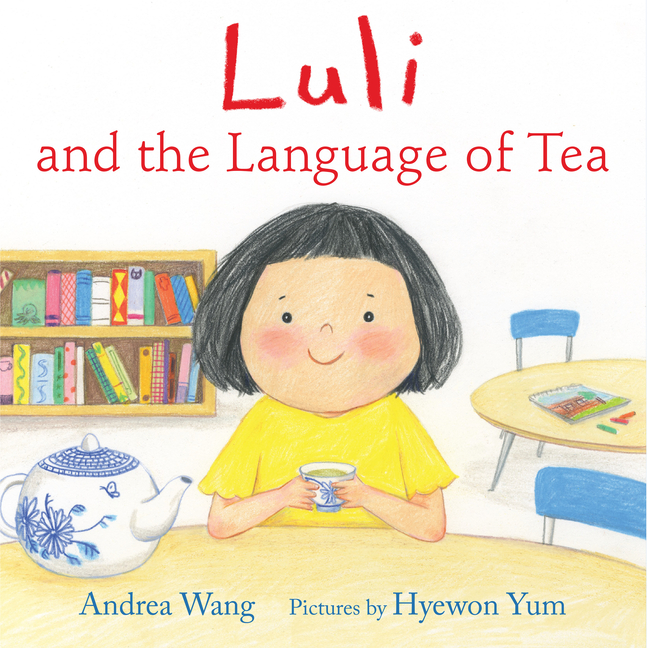Book Descriptions
for Luli and the Language of Tea by Andrea Wang and Hyewon Yum
From Cooperative Children's Book Center (CCBC)
While her mother attends an English as a Second Language (ESL) class, Luli and the children of other ESL learners from various countries spend the time in childcare in the classroom next door. As none of them speak English yet, the kids engage in mostly solitary play—until Luli comes up with an idea. The next day, she carefully unpacks the components for tea at a round table: teapot, thermos of hot water, and a ball of dried green tea leaves. Setting the tea to steep, she takes a breath and calls to the classroom at large, “Chá!” (The Chinese character for “tea” is used, helpfully followed by its transliteration.) The word, though not exactly the same, is familiar to the other kids in the room, and each of them repeat in their own language, “Tea?” There’s “shay” in Arabic, “chay” in Russian, “chah-hee” in Farsi, “teh” in Hebrew, and many more. As they gather around the table, Luli pours them each a cup of tea … and then they all pour a bit of their own portion into Luli’s empty cup. The shared ritual breaks the ice (Luli’s box of cookies helps, too) and soon the children are playing together. Luli’s courage and cleverness shine in this story of cross-cultural connection. Back matter includes information about how tea is traditionally enjoyed in each of the children’s home countries. (Ages 3-7)
CCBC Choices 2023. © Cooperative Children's Book Center, Univ. of Wisconsin - Madison, 2023. Used with permission.
From the Publisher
Though they may speak different languages, kids from all over the world come together to enjoy the shared pastime of tea in this delicious book for young readers.
When five-year-old Luli joins her new English as a Second Language class, the playroom is quiet. Luli can’t speak English, neither can anyone else. That’s when she has a brilliant idea to host a tea party and bring them all together.
Luli removes her teapot, thermos, and teacups from her bag and calls out “Chá!” in her native Chinese. One by one, her classmates pipe up in recognition: in Russian, Hindi, Turkish, Persian, Arabic, and Spanish, Portuguese, and Swahili. Tea is a tasty language they all know well, and it gives them a chance to share and enjoy each other’s company. When all the tea is gone and it’s time for dessert, Luli gets to use her favorite English word, cookie! After that, the playroom isn’t so quiet.
Informed by her own experience as the child of Chinese immigrant parents, Andrea Wang makes the point that when you’re looking to communicate with people, you look for a common bond. The word for “tea” is similar in many languages, and tea becomes the unifying metaphor that brings a diverse group of children together. Additional material at the back of the book explores the rich and ancient history of tea drinking across cultures all around the world and contains maps, statistics, and fascinating details that will delight young readers.
An American Library Association Notable Children's Book
A Booklist Editors’ Choice Selection
A CSMCL Best Multicultural Children's Book of the Year
When five-year-old Luli joins her new English as a Second Language class, the playroom is quiet. Luli can’t speak English, neither can anyone else. That’s when she has a brilliant idea to host a tea party and bring them all together.
Luli removes her teapot, thermos, and teacups from her bag and calls out “Chá!” in her native Chinese. One by one, her classmates pipe up in recognition: in Russian, Hindi, Turkish, Persian, Arabic, and Spanish, Portuguese, and Swahili. Tea is a tasty language they all know well, and it gives them a chance to share and enjoy each other’s company. When all the tea is gone and it’s time for dessert, Luli gets to use her favorite English word, cookie! After that, the playroom isn’t so quiet.
Informed by her own experience as the child of Chinese immigrant parents, Andrea Wang makes the point that when you’re looking to communicate with people, you look for a common bond. The word for “tea” is similar in many languages, and tea becomes the unifying metaphor that brings a diverse group of children together. Additional material at the back of the book explores the rich and ancient history of tea drinking across cultures all around the world and contains maps, statistics, and fascinating details that will delight young readers.
An American Library Association Notable Children's Book
A Booklist Editors’ Choice Selection
A CSMCL Best Multicultural Children's Book of the Year
Publisher description retrieved from Google Books.


